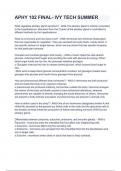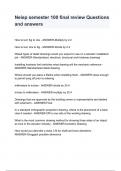APHY 102 FINAL- IVY TECH SUMMER
What regulates pituitary gland secretion? - ANS-The pituitary gland is directly connected
to the hypothalamus. Secretion from the 2 lobes of the pituitary gland is controlled by
different methods by the hypothalamus
What is a hormone and how does it act? - ANS-Hormones are chemical messengers
that are responsible for regulation. They are secreted into body fluids, mainly blood. It
has specific actions on target tissues, which are any tissue that has specific receptors
for that particular hormone.
Compare and contrast glucagon and insulin. - ANS-o Insulin helps the cells absorb
glucose, reducing blood sugar and providing the cells with glucose for energy. When
blood sugar levels are too low, the pancreas releases glucagon.
o Glucagon instructs the liver to release stored glucose, which causes blood sugar to
rise.
• Both work to keep blood glucose concentration constant, but glucagon breaks down
glycogen into glucose and insulin forms glycogen from glucose.
How are pheromones different than hormones? - ANS-o Hormones are both produced
and act inside the body of an organism whereas,
o pheromones are produced interiorly, but function outside the body. Hormone changes
the interior of the body and finally causes to have behavioral alterations, whereas
pheromones are capable of directly changing the social behaviors of others. Hormones
are present in both animals and plants, but pheromones are present in animals only
How is inhibin used in the body? - ANS-One of two hormones (designated inhibin-A and
inhibin-B) secreted by the gonads (by Sertoli cells in the male and the granulosa cells in
the female) and that inhibit the production of follicle-stimulating hormone (FSH) by the
pituitary gland.
Differentiate between paracrine, autocrine, endocrine, and exocrine glands. - ANS-o
Paracrine - hormones enter the interstitial fluid but affect only neighboring cells.
o Autocrine - hormones affect only the secreting cell.
o Endocrine - hormones are secreted from the interstitial fluid into the bloodstream and
act on target cells.
o Exocrine - secretions enter tubes or ducts that lead to body surfaces.
,How is diabetes insipidus different than diabetes mellitus? - ANS-o Diabetes mellitus is
characterized by high levels of sugar in the blood while
o diabetes insipidus is a disease where kidneys are unable to conserve water
Describe steroid hormones. - ANS-All steroid hormones are derived from cholesterol.
These include sex hormones, such as testosterone and the estrogens, and secretion of
the adrenal cortex, including aldosterone and cortisol
Describe tropic hormones - ANS-a hormone that stimulates an endocrine gland to grow
and secrete it's hormones.
Describe normal blood: number of each cell type, pH. - ANS-Blood is about 8% of body
weight. Adult blood volume is about 5 L. RBC count is usually 4,600,000-6,200,000 in
males, 4,200,000-5,400,000 in females. WBC are usually 5,000-10,000 per cubic mm of
blood. Platelets are usually 130,000-360,000 per cubic mm of blood. Normal blood pH is
around 7.4.
How does the Rh factor affect a developing fetus and its mother? - ANS-o Rh positive -
presence of antigen D or other Rh antigens on the RBC membranes.
o Rh negative - lack of these antigens
§ If a mother is Rh negative and her baby is Rh positive, her antibodies form to fight
Rh-positive blood cells. If a mother is Rh positive and her baby is Rh positive, her
antibodies attack the baby's RBC. Complications can lead the baby to develop
erythroblastosis fetalis or hemolytic disease
What antigens can be found on RBC? What antibodies can be found in the plasma?
How do these create different blood types? - ANS-o Antigens: A, B, AB, or none.
o Antibodies: A, B, AB, or none.
o Antibodies are associated with some blood types; in general, a person produces
antibodies against antigens that are not present on his/her RBC membranes. The
antigens expressed on the red blood cell determine an individual's blood group.
Describe the different leukocytes and their origins. - ANS-o Neutrophils - most
numerous, 54-62% of WBCs, first to arrive to fight infections, elevated in bacterial
infections, multi-lobed nucleus.
o Eosinophils - deep red granules in acid stain, bi-lobed nucleus, fight allergic reactions
and against parasitic worm infestations, 1-3% of WBCs.
o Basophils - Deep blue granules in basic stain, release histamine and heparin, <1% of
WBCs.
, o Monocytes - largest of all blood cells, kidney- or oval-shaped nuclei, become
macrophages, 3-9% of WBCs, phagocytize bacteria, dead cells, and other debris.
o Lymphocytes - slightly larger than RBCs, large spherical nucleus surrounded by a thin
rim of cytoplasm, T and B cells, B cells produce antibodies, 25-33% of WBCs.
Compare the formed elements of the blood. - ANS-o Form mostly in red bone marrow,
and are called "formed elements":
§ Red blood cells (R B C s): Red blood cells (erythrocytes). These carry oxygen from
the lungs to the rest of the body
§ White blood cells (W B C s): (leukocytes). These helps fight infections and aid in the
immune process. Types of white blood cells include: Lymphocytes, Monocytes,
Eosinophils, Basophils, Neutrophil
§ Platelets (thrombocytes): Cell Fragments; These help in blood clotting
Describe the steps in clot formation. - ANS-Hemostasis - the stoppage of bleeding.
1. Blood vessel spasm - smooth muscle in blood vessel contracts
2. Platelet plug formation:
a. break in vessel wall
b. blood escapes through break
c. platelets adhere to each other, to end of broken vessel, and to exposed collagen
d. platelet plug helps control blood loss
3. Blood coagulation - clot forms (occurs extrinsically or intrinsically).
What blood types can give/receive to/from other blood types? - ANS-
What are normal levels and percentages of RBC, WBC and platelets? - ANS-In a
centrifuged blood sample:
• 55% is plasma.
• 45% is RBCs.
• WBCs and platelets are <1%.
Compare serum versus plasma. - ANS-o Serum: water fluid from blood without the
clotting factors. And, this is the liquid that remains after the blood has clotted
o Plasma: blood fluid that contains blood clotting agents. And, this is the liquid that
remains when clotting is prevented
What is hematocrit? - ANS-the ratio of the volume of red blood cells to the total volume
of blood





